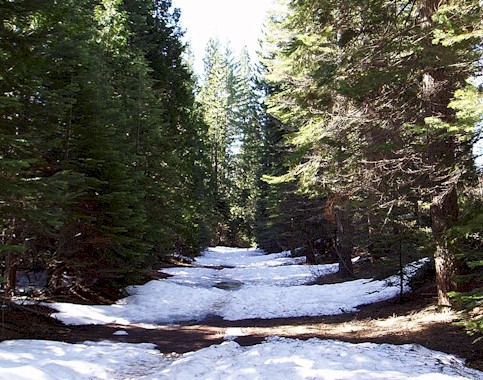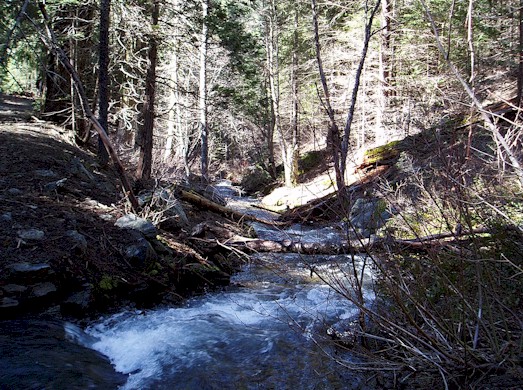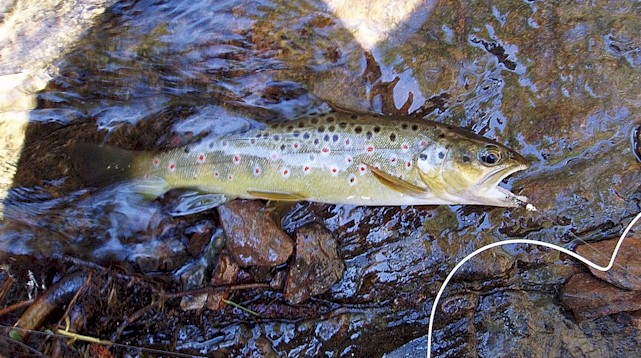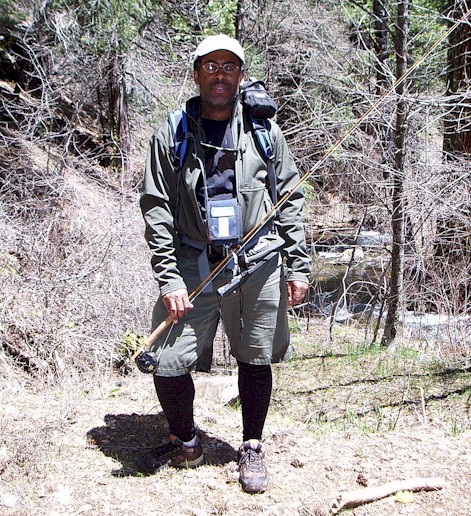|
|
|
|
|
May 7th, 2006- A Yosemite Creek and trib to the South Fork of the Tuolumne River Time:
Mid Morning to Late Afternoon Narrative:
Butterball Creek is a small spring creek in the western portion of the park with a healthy population of deep yellow bellied Brown Trout. The stream where I usually fish it is small, no more than 10 feet across at its widest point and probably no more that 4 feet deep at itís deepest point. Itís fairly brushy, although nothing like the streams in New Mexicoís Sandia Mountains, and itís fish are VERY spooky.
This yearís hike was a little more adventurous than in the past. The huge snow pack that we have this year had some effect on the creek. It was a little higher than I expected, mostly though it affected the trail. The trail had small streams and runoff to be crossed, large pools of soft deep mud to navigate and fallen trees to climb; it was not nearly the straight shot down that I remembered. Normally on this stream, I cross the creek and fish upstream from a round a small bend. Having always worn waders here, IĎd forgotten how unfriendly the stream crossing was. Itís lined by small trees whose branches are sticking out every which way, making it too hard to jump across and the high water covers the rocks which are normally used as stepping stones. At this point I hadnít decided whether I really wanted to wet wade or not so I decided not to cross and to try to fish downstream. This was about as successful as I could have hoped. Downstream from the trail crossing the stream goes into a small canyon carved by the water. Itís littered with steep, slick rocks and trees fallen by a combination of erosion and heavy snow. I made my way downstream, carefully straddling the small and few foot holds that would allow me to stand above the small plunge pools and cast. The position was awkward and dangerous. It was dangerous only in that the slightest loss of concentration would send me into the water. The water was probably shallow enough for me to stand in and keep my head above water but if I hit my head as I fell, getting wet might be the least of my problems. Small streams are fun but they can sure be a challenge. I nymphed today using a small woolly
bugger type nymph. I usually donít fish woolly buggers and often playfully
raz an acquaintance of mine about fishing buggers with bamboo rods.
Truthfully I donít think thereís anything wrong with fishing a bugger. I
simply donít fish them because the fishing can be almost too easy and I much
prefer shortline nymphing without an indicator.
After successfully retrieving fish from two of the lower pools I decided to bite the bullet and cross the stream. The best pool lay below these and the only way to reach them was to cross the stream and work up. The pool was ice cold and wading was painful. I only stayed in the water long enough to cross the stream or make a good presentation. The honey hole was the deepest and widest of the plunge pools in this area. It is at the confluence of the main creek and a tributary. When the water is lower, it is crystal clear and you can sight cast with dry flies. On this day, the water was fast and high, clear but dark and the fish were hidden. I tried to catch fish in this pool but the best presentation was from directly below and I couldnít stand with my lower limbs submerged long enough to get a good drift the length of the pool. I had better success further upstream. As I came around the bend, below the two pools I had first fished, I spotted a fish in a small tail out. I was standing high above this fish on a fallen tree and was sure that the motion of my rod or the splash of my fly would spook it but I had to try. It was a tense fishing situation. I flubbed the first few casts. Too wide, too deep, poor drift, snag a tree- I did it all. Fortunately, the fish seemed to be concentrating on a very narrow section of stream just ahead of it. If the cast was made to far to the left or right, the fish ignored the fly. It seemed that I had to place the fly about 18 inches above and almost dead center of the fish to wrest a response. I did this exactly 3 times. On the first good cast, I struck too soon and pulled the fly away from the fish. I could see the fish and if I waited to see the line move or see the fish suck the fly in, it would be too late. The second cast turned into the atomic nymph and shot past the fish- bad drift. As I made my 3rd cast, I was sure I wasnít going to get too many more shots at this fish. I bad cast or a prick from the fly would put it down for sure. The next cast was spot on. The fish moved a little to the side, I hesitated a second and stuck- FISH ON!
Working my way back around to the stream crossing, I worked upstream as far as I could. Upstream I hooked many fish but landed few. Next time I have to remember to bring a net, especially at the big fish water. The big fish water is comprised of two bath tube sized and shaped plunge pools. For a stream of itís size, Butterball Creek has above average sized fish. Carved in stone, these pools have always given up good fish, Brown Trout pushing 13 inches with beautiful yellow bodies. Iíve always wanted to get a picture of these fish but havenít been able to do so. Today was no different. The pool was high and fast. I duck walked my way through the brush and placed my fly along the seam on the far side of the fast water. The first few drifts the fly caught the current and was shot quickly into the next pool. (Atomic Nymph away!) The next casts I were made along the far bank. There was no bank really, simply the face of a large rock. I made an upstream mend and the back swirling current quickly pulled the sinking fly to the top of the pool and then down along the fast water seem. Almost immediately the fly was taken. Now hereís were the net would have been handy. It was easy enough to quickly play the fish in the soft water on the far side of the pool but between it and I was a torrent of water. The fish were too heavy to lift over the water and my efforts to bring 2 large fish to hand through the fast water resulted in a long distance release both times.
It was mid afternoon when I reached the car and with quick drive I was at another trailhead ready to do some exploring. I was on a tributary to the South Fork of the Tuolumne River. As I recall, Steve Beckís Yosemite Trout book describes the stream as brushy and difficult to fish but he makes it seem as if it's bigger than Butterball Creek. Given the time of year and his description, I figured that this stream would be running high and fast and that a trip to the upper portion would be appropriate. By all the accounts, the upper portion would be a reasonable place to fish. I didnít find this to be the case. Two fairly quickly descending miles from the trailhead, the stream is supposed to cross under a bridge and you can start fishing from there. Weíll, I must not have hiked far enough because the stream at the bridge I came to was pitiful- small, despite the run off with very little good holding water. Still, it might hold fish so I took 15 minutes to fish the best holding areas I could find. Nada, nothing, zilch, zipÖnot a fish in sight. It was late afternoon by now and I was feeling my near 40 years, round middle and 3 hours of ďmore difficultĒ hiking. The area is fairly bear intensive and I didnít want to find my self dodging bears at dusk so I made my way out of the canyon. On the way, I stopped to snap a picture at one of Yosemiteís more familiar sites. A high trib to this stream actually flows past this tree and it actually looks as if it would hold fish but I didnít feel comfortable crossing the small barrier put up by the forest service and fishing in front of all the tourists.
Previous Yosemite / Ansel Adams Wilderness Chronicle Next Yosemite / Ansel Adams Wilderness Chronicle
|

 The
hike to Butterball Creek is fairly deceptive. This early in the year, the
trailhead looks snowed in because of the packing it gets from constant cross
country ski use. Itís a fairly easy hike, basically straight down for a
mile. The hike out is the killer and as the Yosemite trail markers say, it
is ďmore difficultĒ. Last year Gino and I tried to find a shorter way into
the stream via a public fire road but to no avail; the conditions where
simply too unpleasant for his two wheel drive Tacoma.
The
hike to Butterball Creek is fairly deceptive. This early in the year, the
trailhead looks snowed in because of the packing it gets from constant cross
country ski use. Itís a fairly easy hike, basically straight down for a
mile. The hike out is the killer and as the Yosemite trail markers say, it
is ďmore difficultĒ. Last year Gino and I tried to find a shorter way into
the stream via a public fire road but to no avail; the conditions where
simply too unpleasant for his two wheel drive Tacoma. 
 Getting
back to the report. I fished these first few plunge pools with a BH Prince
and Dark Lord. My version of the BH Prince works well here but I havenít
tied any of those in about 3 years. The BMN is very similar, so when the
Prince and Dark Lord didnít work, I tied one on. I didnít have to change
flies the rest of the day.
Getting
back to the report. I fished these first few plunge pools with a BH Prince
and Dark Lord. My version of the BH Prince works well here but I havenít
tied any of those in about 3 years. The BMN is very similar, so when the
Prince and Dark Lord didnít work, I tied one on. I didnít have to change
flies the rest of the day.
 On
the high note of big fish, it was time to hike out. I occasionally meet
people down in this canyon looking for a landmark that doesnít seem to
exist. They hike down the trail to an earlier point of interest and are
curious about the supposed second point of interest a mile further. To my
knowledge, there is no second point of interest and most folks turn back at
the second stream crossing. Such was the case today and I took advantage of
this by having a quick photo snapped.
On
the high note of big fish, it was time to hike out. I occasionally meet
people down in this canyon looking for a landmark that doesnít seem to
exist. They hike down the trail to an earlier point of interest and are
curious about the supposed second point of interest a mile further. To my
knowledge, there is no second point of interest and most folks turn back at
the second stream crossing. Such was the case today and I took advantage of
this by having a quick photo snapped. 